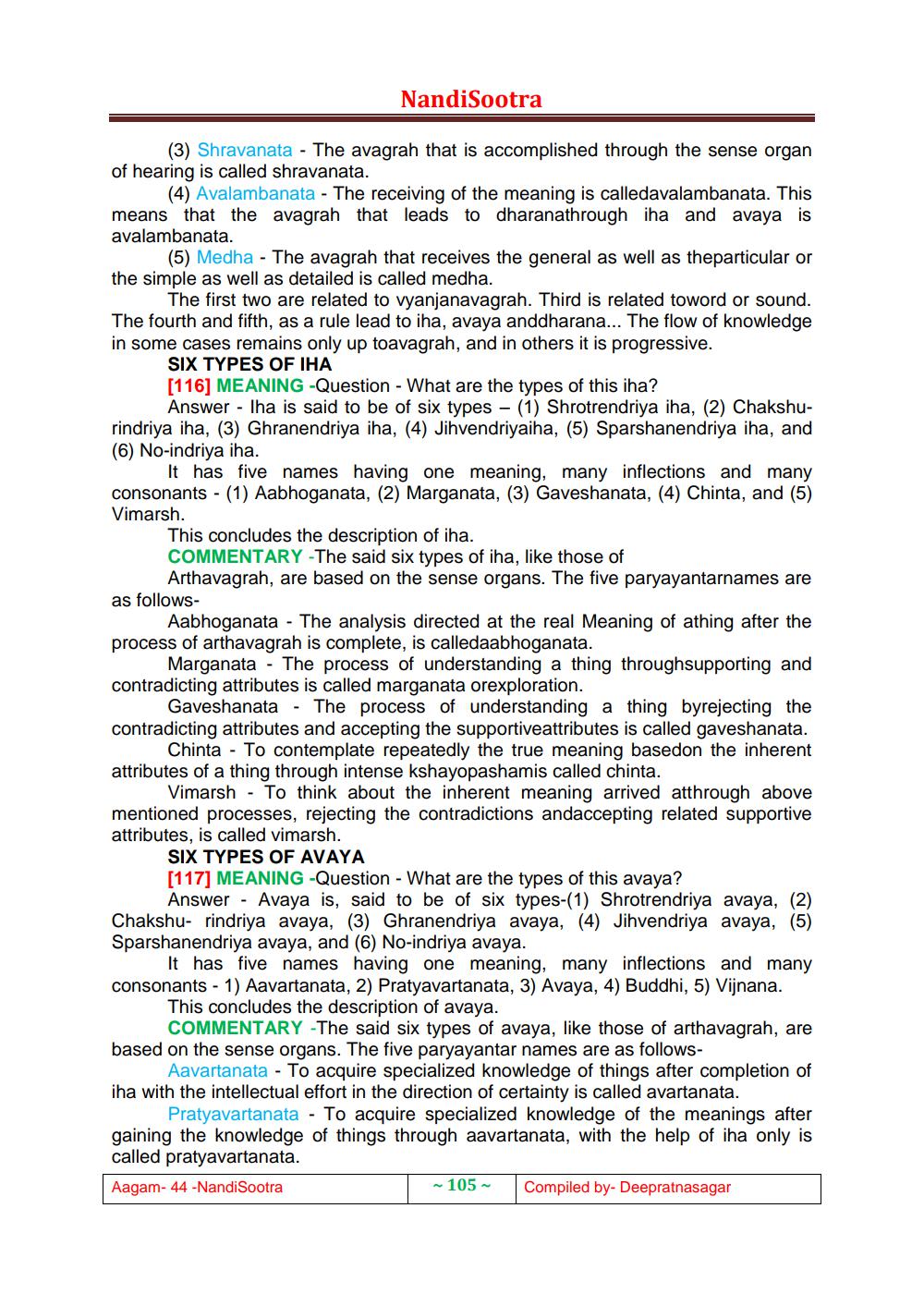________________
NandiSootra
(3) Shravanata - The avagrah that is accomplished through the sense organ of hearing is called shravanata.
(4) Avalambanata - The receiving of the meaning is calledavalambanata. This means that the avagrah that leads to dharanathrough iha and avaya is avalambanata.
(5) Medha - The avagrah that receives the general as well as theparticular or the simple as well as detailed is called medha.
The first two are related to vyanjanavagrah. Third is related toword or sound. The fourth and fifth, as a rule lead to iha, avaya anddharana... The flow of knowledge in some cases remains only up toavagrah, and in others it is progressive.
SIX TYPES OF IHA [116] MEANING -Question - What are the types of this iha?
Answer - Iha is said to be of six types – (1) Shrotrendriya iha, (2) Chakshurindriya iha, (3) Ghranendriya iha, (4) Jihvendriyaiha, (5) Sparshanendriya iha, and (6) No-indriya iha.
It has five names having one meaning, many inflections and many consonants - (1) Aabhoganata, (2) Marganata, (3) Gaveshanata, (4) Chinta, and (5) Vimarsh.
This concludes the description of iha. COMMENTARY -The said six types of iha, like those of
Arthavagrah, are based on the sense organs. The five paryayantarnames are as follows
Aabhoganata - The analysis directed at the real Meaning of athing after the process of arthavagrah is complete, is calledaabhoganata.
Marganata - The process of understanding a thing throughsupporting and contradicting attributes is called marganata orexploration.
Gaveshanata - The process of understanding a thing byrejecting the contradicting attributes and accepting the supportiveattributes is called gaveshanata.
Chinta - To contemplate repeatedly the true meaning basedon the inherent attributes of a thing through intense kshayopashamis called chinta.
Vimarsh - To think about the inherent meaning arrived atthrough above mentioned processes, rejecting the contradictions andaccepting related supportive attributes, is called vimarsh.
SIX TYPES OF AVAYA [117] MEANING -Question - What are the types of this avaya?
Answer - Avaya is, said to be of six types-(1) Shrotrendriya avaya, (2) Chakshu- rindriya avaya, (3) Ghranendriya avaya, (4) Jihvendriya avaya, (5) Sparshanendriya avaya, and (6) No-indriya avaya.
It has five names having one meaning, many inflections and many consonants - 1) Aavartanata, 2) Pratyavartanata, 3) Avaya, 4) Buddhi, 5) Vijnana.
This concludes the description of avaya.
COMMENTARY -The said six types of avaya, like those of arthavagrah, are based on the sense organs. The five paryayantar names are as follows
Aavartanata - To acquire specialized knowledge of things after completion of iha with the intellectual effort in the direction of certainty is called avartanata.
Pratyavartanata - To acquire specialized knowledge of the meanings after gaining the knowledge of things through aavartanata, with the help of iha only is called pratyavartanata. Aagam- 44 -NandiSootra
~ 105 - Compiled by- Deepratnasagar
Dr




